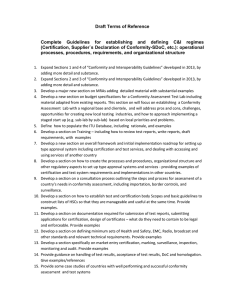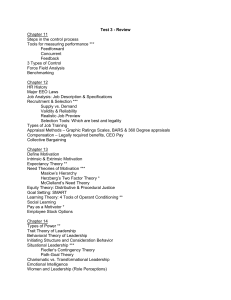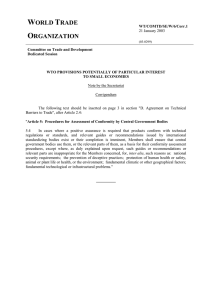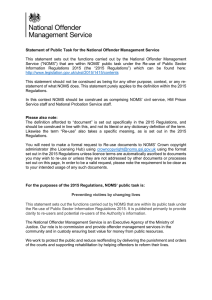Mandatory Standards and Labeling Requirements
advertisement
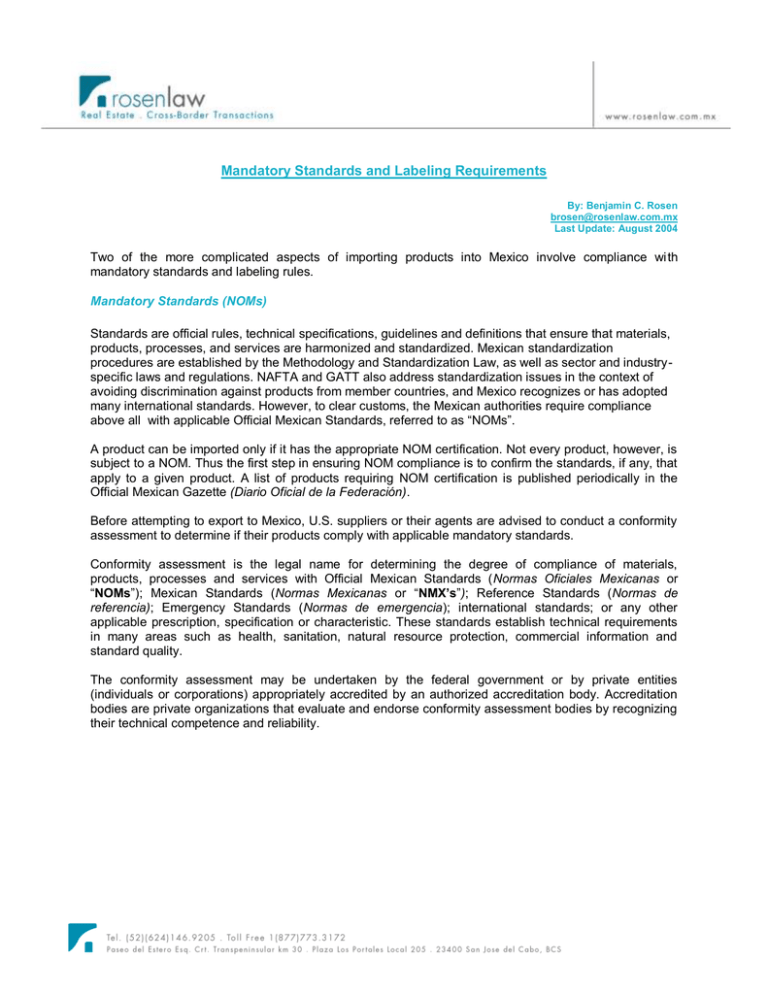
Mandatory Standards and Labeling Requirements By: Benjamin C. Rosen brosen@rosenlaw.com.mx Last Update: August 2004 Two of the more complicated aspects of importing products into Mexico involve compliance with mandatory standards and labeling rules. Mandatory Standards (NOMs) Standards are official rules, technical specifications, guidelines and definitions that ensure that materials, products, processes, and services are harmonized and standardized. Mexican standardization procedures are established by the Methodology and Standardization Law, as well as sector and industryspecific laws and regulations. NAFTA and GATT also address standardization issues in the context of avoiding discrimination against products from member countries, and Mexico recognizes or has adopted many international standards. However, to clear customs, the Mexican authorities require compliance above all with applicable Official Mexican Standards, referred to as “NOMs”. A product can be imported only if it has the appropriate NOM certification. Not every product, however, is subject to a NOM. Thus the first step in ensuring NOM compliance is to confirm the standards, if any, that apply to a given product. A list of products requiring NOM certification is published periodically in the Official Mexican Gazette (Diario Oficial de la Federación). Before attempting to export to Mexico, U.S. suppliers or their agents are advised to conduct a conformity assessment to determine if their products comply with applicable mandatory standards. Conformity assessment is the legal name for determining the degree of compliance of materials, products, processes and services with Official Mexican Standards (Normas Oficiales Mexicanas or “NOMs”); Mexican Standards (Normas Mexicanas or “NMX’s”); Reference Standards (Normas de referencia); Emergency Standards (Normas de emergencia); international standards; or any other applicable prescription, specification or characteristic. These standards establish technical requirements in many areas such as health, sanitation, natural resource protection, commercial information and standard quality. The conformity assessment may be undertaken by the federal government or by private entities (individuals or corporations) appropriately accredited by an authorized accreditation body. Accreditation bodies are private organizations that evaluate and endorse conformity assessment bodies by recognizing their technical competence and reliability. Labeling Requirements Imported products must comply with labeling NOMs. The product label can either be verified during the customs process or labeled in an authorized or private warehouse by Authorized Verification Units (Unidades de Verification Autorizadas (UVAs). The most common UVAs specialize in consumer information labels, but some focus on sanitary measures and other standards. Many companies find these government-approved UVAs very useful for satisfying NOM requirements. The Standards Office of the Secretary of Economy (Direccion General de Normas) has published labeling guidelines that specify matters such as letter size, colors, language and other characteristics of a product’s label. The default labeling NOM is NOM-050-SCFI-I994. It establishes the labeling requirements for all products that do not have a specific labeling NOM. Some product-specific labeling NOMs include: NOM-004-SCFI-1994.- Clothing and textiles NOM-05I-SCFI-I994.- Packaged foods and nonalcoholic beverages NOM-084-SCFI-1994.- Canned tuna NOM-142-SSAI -1995.- Alcoholic beverages NOM-141-SSA1-1995 – Packaged beauty supplies and perfumery NOM 050 establishes that all labels on products subject to the NOM must include the following commercial information: a) Name or generic denomination of the product, if not identifiable in plain sight by the consumer b) Net contents of the product c) Name and legal address of the manufacturer or party responsible for the manufacture of domestic products. For imported products, this information must be provided to the Secretary of Health by the importer upon the Secretary’s request. The Secretary shall provide this information to consumers requesting it in regard to filing product complaints. d) A legend identifying the product’s country origin, such as “producto de . . .”, “hecho en . . .”, “manufacturado en . . .” (“product of . . .”, “made in . . .”, “manufactured in . . . .”), or another similar phrase, in accordance with the international treaties to which Mexico is a party. e) Warnings provided through legends, graphics, or warning symbols with respect to dangerous products. f) When product use, administration, or conservation requires instructions, this information must be indicated on an instruction sheet, label, or in an attached operating manual. The label must show “VEASE INSTRUCTIVO ANEXO” or “MANUAL DE OPERACION ANEXO” (SEE ATTACHED INSTRUCTION SHEET or OPERATING MANUAL ATTACHED). g) As applicable, the expiration date or date of recommended consumption. h) Regarding imported products, the importer’s name and legal address. This information may be included on the product in Mexico after clearing customs but before the product is sold. By: Benjamin C. Rosen 2 Toll Free from US: 1(877) 773-3172 Updated: August 204 QUESTIONS & ANSWERS Question: how does the standardization process work in Mexico? What are the types of standards? Answer: Technical standards in Mexico are divided into two basic categories: mandatory and voluntary. NOMs, emergency standards and reference standards are compulsory standards. The remaining types of standards are voluntary. NOMs are considered binding upon all parties within their scope. Legal action may be taken against noncomplying companies or individuals. NOMs can be issued only by the federal government through national advisory standardization committees (comités consultivos nacionales de normalización). The content of these standards cannot be arbitrarily determined by the government. By law, NOMs must be subject to public discussion before their final versions are published in the Official Gazette. Emergency standards are basically like NOMs except that they are temporary and are not subject to public consultation. Federal agencies are empowered to issue emergency standards only when a contingency justifies replacing the regular process for creating NOMs. Reference standards are those that contain specifications that must be met by the goods and services federal agencies intend to acquire. This type of standards is binding only for federal agencies and does not apply to the providers of those goods and services. NMX’s are voluntary standards and are intended to improve the quality of goods and services. They are issued by National Standardization Bodies (organismos nacionales de normaización) or the federal government and are also subject to public discussion before being published in the DOF. National Standardization Bodies are private entities that have received a “registration” by the government to draft and issue NMX’s. Question: who is entitled to undertake the Conformity Assessment Process? There are several types of conformity assessors, namely: (i) testing and calibration laboratories; (ii) certification bodies, and (iii) verification units. Testing and calibration laboratories test and calibrate a representative sample of material or equipment and issue a Report of Findings. Certification bodies examine a product lot or a system of production, quality and management and then issue a Certificate. Verification units conduct their work by confirmation or proof through sampling, measuring, laboratory tests, or document revision, before issuing a Certificate or Verdict. Certification is a form of conformity assessment, and refers specifically to the assessment of goods and systems. Those in charge of performing the conformity assessment of products are called Product Certification Bodies (Organismo de Certificación de Producto). When imported goods are subject to NOMs, they are normally assessed by a product certification body. If a NOM establishes labeling requirements, compliance must be evaluated by a verification unit. Certification bodies and verification units, as well as any other type of conformity assessors, must be appropriately accredited. Conformity assessors must be approved by the federal government. By: Benjamin C. Rosen 3 Toll Free from US: 1(877) 773-3172 Updated: September 2006 Question: how can exporters know if their products must comply with NOMs? Answer: Exporters must first contact their customs agent to determine the tariff fraction (fracción arancelaria) that is applicable to the goods they want to export. The tariff fraction is a numerical code that permits exporters to identify their goods for customs and tax purposes. Question: how can exporters get their products certified? Answer: If the exporters’ goods are subject to NOMs, they must be evaluated by a conformity assessor accredited by the Mexican Accreditation Entity (Entidad Mexicana de Acreditación, A.C. – EMA), the only accreditation body in Mexico at this time. The appropriate conformity assessors for evaluating goods are product certification bodies. If the applicable NOM establishes labeling requirements, an evaluation by a verification unit is also necessary. Under Mexican legislation, conformity assessors accredited by a foreign accreditation body do not comply with NOM certification requirements. The rulings of conformity assessors accredited by a foreign accreditation body may be valid in Mexico for customs purposes, only if a recognition agreement exists between the involved accreditation bodies or conformity assessors. Question: what happens if the Conformity Assessment process is omitted? Answer: Goods that do not comply with the applicable NOMs may not be imported. Customs authorities are in charge of verifying that importers prove their products’ compliance with all applicable mandatory standards (NOMs). Mexico’s Federal Law on Measures and Standards (Ley Federal sobre Metrología y Normalización) ensures the enforcement of the conformity assessment process through various sanctions, including imprisonment. DISCLAIMER: THIS DOCUMENT IS FOR INFORMATIONAL PURPOSES ONLY. READERS ARE ADVISED TO RETAIN QUALIFIED LEGAL COUNSEL BEFORE BUYING OR SELLING REAL PROPERTY IN MEXICO. NOWHERE IN THIS DOCUMENT IS THE AUTHOR PROVIDING LEGAL ADVICE TO THE READER NOR SHALL THE CONTENTS OF THIS DOCUMENT BE INTERPRETED IN ANY WAY TO ESTABLISH AN ATTORNEY-CLIENT RELATIONSHIP BETWEEN THE AUTHOR AND THE READER. ALTHOUGH THE INFORMATION PROVIDED HEREIN IS BELIEVED TO BE ACCURATE AS OF THE DATE PREPARED, THE AUTHOR MAKE NO SUCH REPRESENTATION. By: Benjamin C. Rosen 4 Toll Free from US: 1(877) 773-3172 Updated: September 2006
